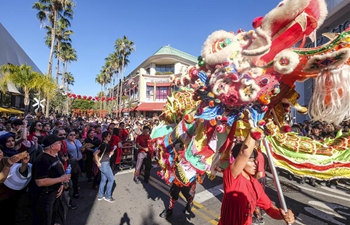BEIJING, Jan. 29 (Xinhua) -- Quality has outweighed pure speed in economic growth in the eyes of local government officials as China deepens its structural supply-side reform.
At the annual provincial legislative sessions, different economic growth performances last year, and targets set for this year, with supporting measures ranging from innovation to opening up, have highlighted the vital transition.
China's GDP expanded 6.9 percent in 2017, picking up for the first time in seven years. Yet more than half of its 31 provinces, regions and municipalities saw their economic growth rates slow last year. Tianjin slowed the most, from 9 percent in 2016 to 3.6 percent in 2017.
The GDP of southern Guangdong Province and eastern Jiangsu Province reached nearly 9 trillion yuan (1.4 trillion U.S. dollars) and 8.6 trillion yuan last year, respectively, ranking first and second among 31 provincial-level regions.
The GDP of Shanghai grew 6.9 percent year-on-year to hit 3 trillion yuan, ranking the first among cities.
As good results from structural reform, the GDP of coal-rich Shanxi Province grew 7 percent last year, compared with 4.5 percent in 2016. The northeastern Liaoning Province, part of the old industrial base, reported 4.2 percent growth from a 2016 contraction.
Drawing development blueprints, a number of places such as Tianjin, Anhui, Gansu, Chongqing and Inner Mongolia, lowered their expected growth targets for 2018 compared with the ones they had set for 2017.
The change highlighted the pursuit of high-quality development at the local level after decades of rapid growth, which has made China's economy rise to the world's second largest after the United States.
"The adjustments of targets show local governments put less emphasis on the pure expansion of GDP and pay more attention to structural reform," said Zhang Peng, assistant researcher with the Chinese Academy of Social Sciences.
Central China's Hubei Province lowered its target from around 8 percent for 2017 to 7.5 percent this year.
"The adjustment is practical. With the hard task of cutting overcapacity and high environmental protection standards, Hubei needs to leave space for economic transition," said Zou Wei, a provincial political advisor and professor of Wuhan University.
While pledging to further reform in their pilot free trade zones, coastal Tianjin, Shanghai, Zhejiang and Guangdong listed the exploration of the construction of free trade ports as their work agendas this year.
The moves came after the 19th National Congress of the CPC in October last year, which said the country would grant more powers to pilot free trade zones to conduct reform and explore the opening of free trade ports.
Ying Yong, mayor of Shanghai, said the city planned to apply a negative list approach to market entry, which states sectors and businesses that are off limits to foreign investment. The move is expected to give foreign firms greater opportunities in China's market.
Tianjin authorities regard 2018 as a decisive year for the port city's economic transition and set a 5-percent growth target this year.
The eastern Shandong Province set up a government fund of 40 billion yuan in January to foster new growth drivers in high-tech and emerging sectors and boost opening-up.
Overcapacity cutting remains one of the priorities. Shanxi will further cut its outdated coal production capacity by around 23 million tonnes this year in an effort to improve the environment.
The country's leading steel and iron producer Hebei Province aims to cut production capacity of steel and iron, and coal, by 10 million and 10.6 million tonnes, respectively, this year, and eliminate all zombie enterprises in the steel industry.
"The province will draft a three-year plan to continue pushing forward industrial reform through market and law-based means, and stricter standards in quality, environmental protection, energy consumption and safety," Hebei governor Xu Qin said.
To boost innovation, Guangdong will increase the percentage of R&D expenditure in its GDP to 2.7 percent this year, while Shanghai will keep its 3.8 percent level.
"A feature of the new era is the pursuit of high-quality development," said Xu Hongcai, an economist with the China Center for International Economic Exchanges.
















